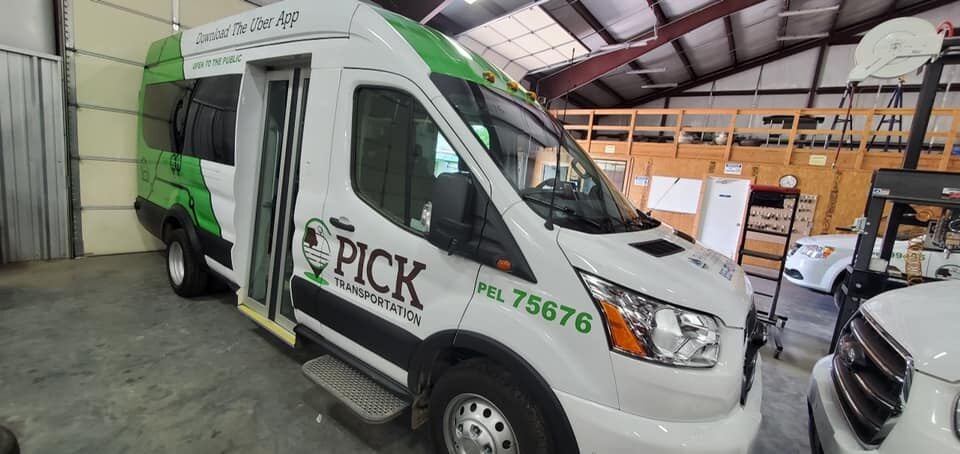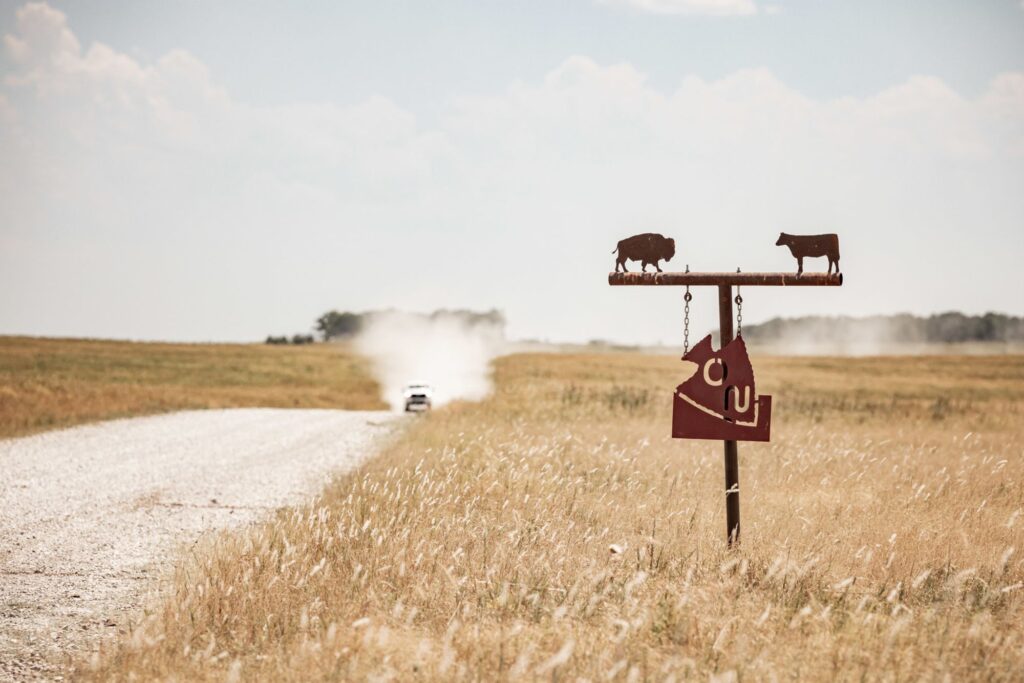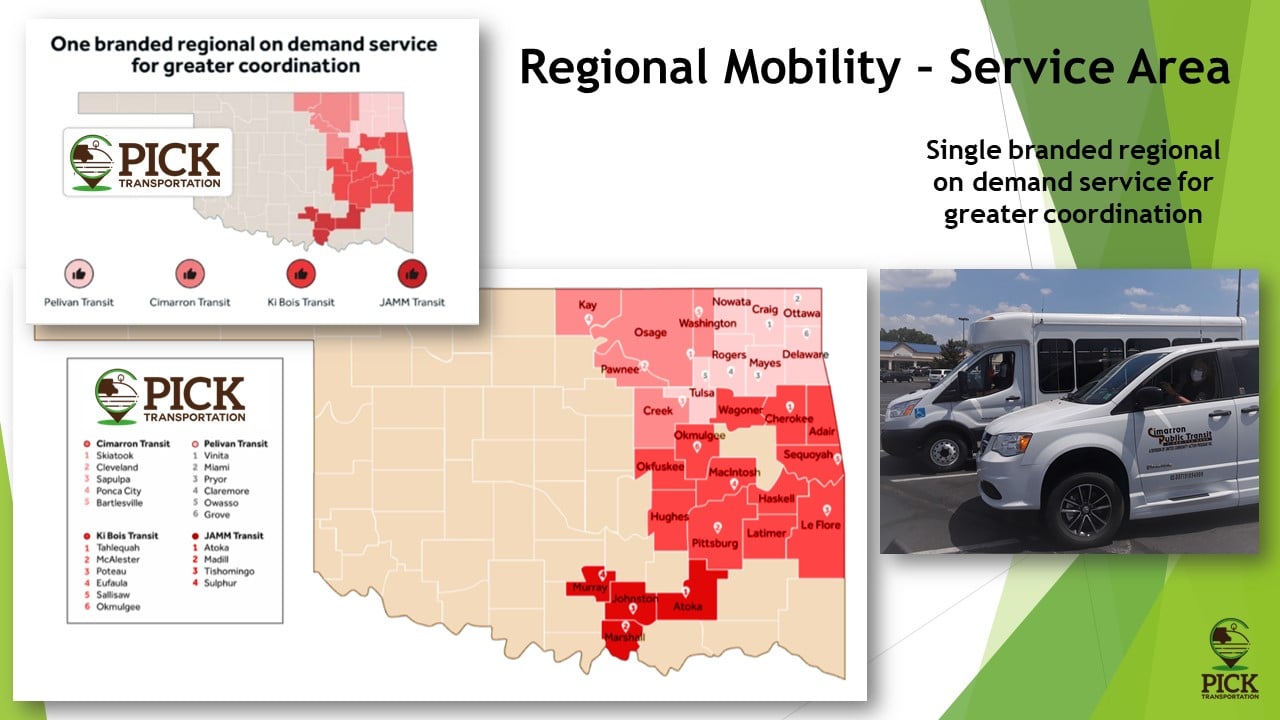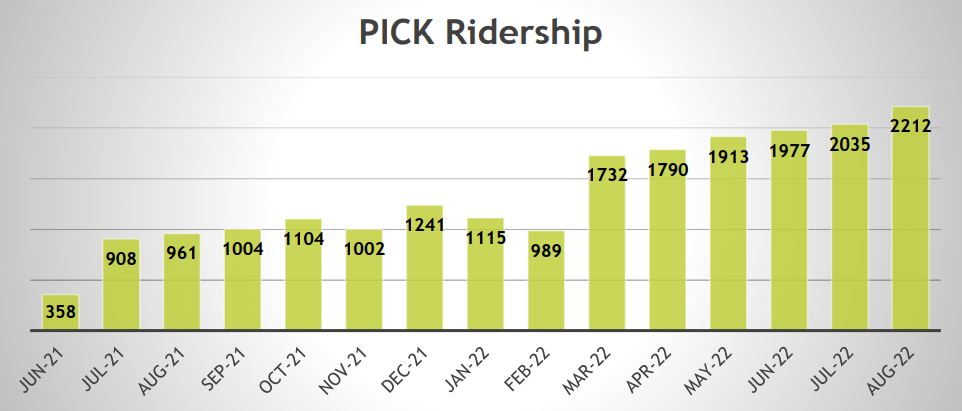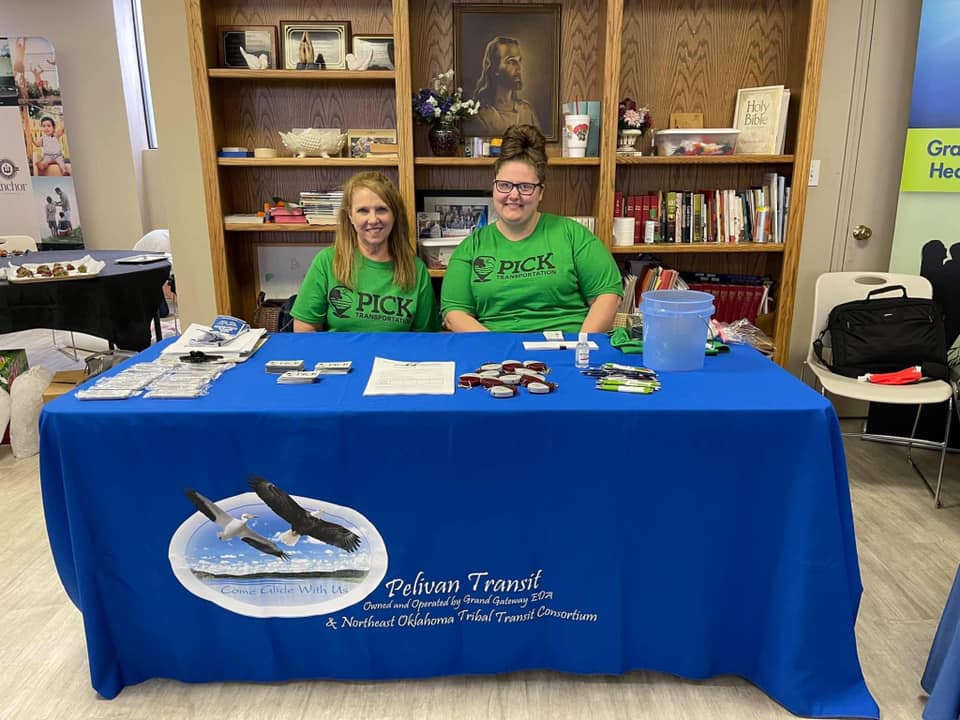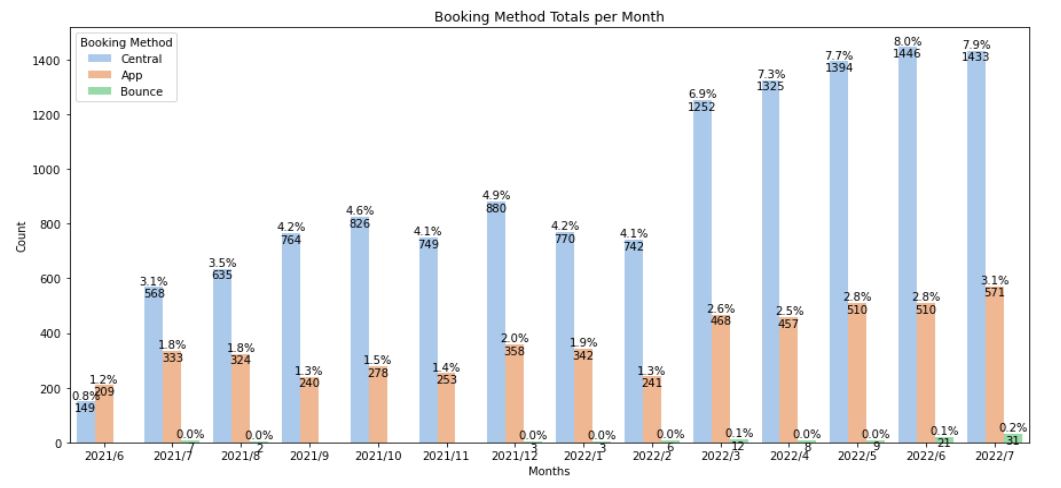Bringing Regional Mobility-On-Demand Service to Rural Oklahoma: A Case Study of PICK Transportation
20 minutes Author: Shared-Use Mobility Center Date Launched/Enacted: Jun 1, 2021 Date Published: March 17, 2023
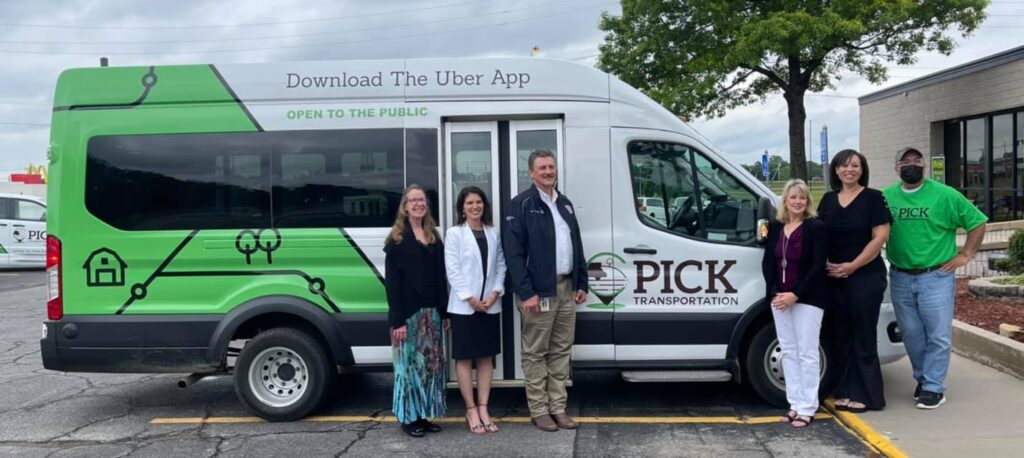
Brief Summary
- In 2021, The Grand Gateway Economic Development Association received a Federal Transit Administration Integrated Mobility Innovation grant of $1.5 million dollars to develop PICK Transportation, an on-demand microtransit service in the rural and tribal areas of eastern Oklahoma.
- A consortium of 4 rural transit agencies and 10 tribal nations participate in the PICK program to provide on-demand public transportation to 21 rural communities in Oklahoma.
- The PICK Program has navigated challenges related to the ongoing national driver shortage, technology literacy of moving toward an app-based booking system, and data needs.
- PICK Transportation partners with Uber to provide the software component of the microtransit service. This software provides the dispatching, booking, payment, and trip planning capabilities of the service.
Description: Video interview with Kendra McGeady, Director of Pelivan Transit.
Credit: Shared-Use Mobility Center (SUMC)
This pilot project is part of the Mobility Innovation Collaborative (MIC) program. The MIC program provides a comprehensive suite of technical assistance resources, promotes knowledge sharing activities, and captures stories and lessons learned from nearly 50 innovative mobility projects across the United States.
Originally published March 2023, revised May 2025.
Introduction
The Grand Gateway Economic Development Association received a Federal Transit Administration’s Integrated Mobility Innovation grant of $1.5 million dollars to support PICK Transportation, an on-demand microtransit service connecting riders to many destinations, including shopping, medical facilities, and restaurants. The PICK Transportation model consists of a consortium of public and tribal transit providers seeking to provide rural communities in eastern Oklahoma access to convenient service as well as mobile booking and payment options.
History of the Program
The lead agency and applicant for the IMI project, Pelivan Transit, provides transit services for the general public and two tribal consortium’s, including the Cherokee Nation and the Northeast Oklahoma Tribal Transit Consortium (NTTC), consisting of nine tribal nations (Eastern Shawnee, Miami, Modoc, Ottawa, Peoria, Quapaw, Seneca-Cayuga, Shawnee, and Wyandotte). However, PICK Transportation isn’t operated by a singular transit agency.
The PICK Transportation Consortium brings together four rural transit providers (i.e., Pelivan Transit, JAMM Transit, Cimarron Public Transit System, KI BOIS Area Transit System (KATS) ll) and nine tribal nations to provide after-hours transportation to 21 rural communities. The consortium initially originated from the Veterans Ride Connect (VRC) program initiative, where the four transit providers previously partnered to connect veterans with rides to 29 rural counties across the region on weekdays between 6:00 am – 6:00 pm.
Throughout the years, the respective agencies involved in the VRC program were able to talk about common transportation problems their agencies and riders were experiencing and found that many of their users needed evening transportation. The established working relationship between transit providers and tribal nations within Oklahoma’s northeast region provided the foundation for the PICK Transportation consortium and subsequent service to kick off. PICK Transportation officially launched in June 2021 in the communities of Atoka, Bartlesville, Owasso, and Tahlequah and has since added 17 other rural communities to the roster. While the FTA funded pilot service was originally set to end in June of 2022, it received an extension through June 30, 2023. Thanks to an operational match provided by the Oklahoma Department of Transportation, PICK Transportation is still operating, with some participating transit agencies utilizing FTA 5310 Formula funds to extend their mobility-on-demand service.
Program Goals
The PICK Transportation initiative taps into providing additional transportation services to individuals after work hours. In rural areas that have public transportation services, it is common that providers end service around 4:00 or 4:30 pm, creating gaps in access for individuals looking to visit various destinations during evening hours. PICK Transportation fills that gap and offers community members an on-demand travel option where individuals can book trips spontaneously rather than two-three days in advance.
The knowledge captured from this pilot program can be shared with other rural transportation providers in the United States looking to join or establish similar programs, as few rural and regional on-demand models exist today.
Program Operations
PICK Transportation offers off-peak point-to-point microtransit service to 21 communities that vary in population size but have similar socio-demographic characteristics. Community populations range from 36,000 people in Bartlesville, OK, to about 2000 in Atoka, OK. The service operates between 5:00 pm and 10:00 pm Monday thru Friday and 10:00 am – 2:00 pm on Saturday. Since PICK Transportation is a single-branded service, it operates the same hours in every service area and uses a standard fare structure of $3 dollars per trip one way. While $3 dollars is more than some participating transit providers charge customers who ride their regular transit service, it was important that the program had a standard fare cost to enable succinct operations across providers.
Individuals looking to utilize PICK Transportation can book rides through Uber’s mobile app or website, or by calling by phone the region’s mobility management center (RMMC). Initially funded by a Veterans Transportation & Community Living Initiative (VTCLI) grant, the RMMC serves as a one-call/one-click center for coordinating regional transportation services within Northeast Oklahoma. When a ride is requested, users receive in-app notifications about their ride status and have access to the map interface, which shows the distances between users’ locations, pick-up points, and the driver’s location in real time. Those without smartphones can receive a robot call or an SMS with details about their trip and driver and a link to a live map showing their driver’s location before and after pick-up.
Given that the PICK Transportation service is open to the general public, it was important for the service to cater to the different needs, abilities, and characteristics of varying individuals. PICK Transportation is a fully ADA-compliant service that operates a fleet of 41 vehicles. The service also offers different booking and payment options to customers. Integrated payment options available in the mobile app support credit or debit cards, Paypal, Apple Pay, and gift cards; however, those without access to traditional financial services can directly pay the driver with cash. Whether an individual is unbanked, doesn’t have reliable internet access, or lacks a personal smartphone, PICK Transportation can still attend to their travel needs.
Ridership
PICK Transportation was planned during the height of the COVID-19 pandemic and officially launched in June 2021, when public health was still a concern. While it’s difficult to conclude the exact impact COVID-19 had on program ridership, health safety concerns and social distancing protocols that prevented in-person outreach likely influenced service usage and travel behavior, particularly in the first month of service. Fortunately, ridership has increased throughout the pilot project’s lifetime, with PICK Transportation serving upwards of 2000 trips a month.
In addition to COVID-19, weather-related impacts have also influenced PICK ridership. Oklahoma is no stranger to harsh weather conditions like snowstorms and freezing temperatures that bring icy conditions to roadways throughout the year. During February 2022, ice and snow storms hit rural Oklahoma, causing the service to shut down. Although this led to decreased ridership that month, PICK Transportation was able to bounce back, and ridership has continued to grow.
Outreach and Marketing
PICK Transportation markets its service through various communication channels, including social media, wrapping vehicles, distributing flyers, or setting up booths at community events or senior fairs. Community events allow the team to share marketing items, spread awareness of the service, and answer questions.
With the recognition that the PICK Transportation service would be leveraging technology unfamiliar to all user groups, the team did extensive outreach to engage community members in booking and planning trips. In the beginning stages of the project, COVID-19 presented challenges with engaging individuals in person; however, the project team pivoted and hosted training sessions on zoom and made training videos accessible on their Facebook page and website.
When in-person engagement resumed, the project team hosted training clinics at various destinations throughout the 21 communities, including senior citizen centers, assisted living centers, and libraries. Within the multi-format training sessions, participants were taught how to schedule rides through the call center and by using a laptop or mobile device. On the mobile training side, participants learned how to create an account and navigate through the Uber application. The team found that hands-on training was the most successful.
Lastly, adapting and pivoting the service to best suit the needs of PICK Transportation riders was also essential to the service’s success. As a result, a short rider survey was made available on the website and Uber app to garner feedback on the PICK Transportation program and the shared-ride service. To compensate people for their time, all participants who fill out the survey receive a voucher for two free PICK trips.
Challenges and Lessons Learned
Driver Shortage
Like many agencies, the national driver shortage has been a constant challenge for PICK Transportation. The need for drivers caused the service to close during evening hours. Current drivers have dedicated more time to picking up shifts, resulting in the program having to allocate money toward overtime pay. The service has never run at full capacity in any of the 21 communities strictly because of the driver shortage. Since the workforce has yet to return, the project team has made adjustments, including increased driver pay, to ensure that the service can continue operating to the best of its ability. Additionally, in an effort to recruit more drivers, PICK Transportation and Pelivan Transit set up marketing booths at local job fairs where interested parties can fill out employment applications.
Technology and Outreach
Technology has reinvented on-demand transportation services and enabled automation of all on-demand scheduling and planning processes, unlocking greater efficiencies on the operations side and offering a more seamless travel experience for the rider via user-facing mobility applications. Customers who want to use PICK Transportation services can request rides by calling in or booking on the Uber App; however, using technology can be difficult for older individuals. The PICK Transportation program has found that the smaller communities it operates within tend to be less familiar with smartphone technology, directly impacting how riders experience the service. In these communities, riders are more likely to call the Regional Mobility Management Center to book rides rather than utilize the smartphone application. To address the user learning curve that comes with incorporating technology into transportation services, the project team led several small in-person training events to improve technological literacy and lower the number of dial-in ride requests.
As PICK Transportation looks to move into daytime service, the team plans to introduce incentives to drive people towards using the smartphone application. For instance, PICK Transportation is looking at making it so that if riders want to book trips for same-day pickup, they will have to use the tech-based mobile application. The PICK Transportation team believes that getting more people to try out the mobile application will allow them to see how well-suited it is to serve their needs.
Meanwhile, with this being a first-of-its-kind service in Oklahoma, the participating transportation providers’ drivers also needed to acclimate to the mobility-on-demand technology. On the operations side, it was a considerable feat to get the agencies to transition their on-demand scheduling and planning processes away from pen to paper and leverage modern tools. While a few transit providers within the consortium adopted automated mobility on-demand technologies, some still did their scheduling on pen and paper. COVID-19 exacerbated issues regarding preparing the operations teams for PICK Transportation service because training could not occur in person. Eventually, Uber was able to conduct training in person, first visiting the PICK Transportation team and then going to each participating transit provider.
PICK Transportation found that familiarizing each transit agency with the technology was easiest when each team had one staff member who was well-versed in navigating the software because they could directly support and grow internal knowledge of the platform on the spot. Building an internal knowledge base offers the opportunity to address questions promptly and avoids the delay of waiting to hear back from an external party. Ultimately while mobility-on-demand technology can be simple to navigate, agencies looking to integrate said technologies into new or current services must create training opportunities to ensure that staff and customers are well-equipped to navigate such platforms.
Data
Analyzing the trip data for each community is an important aspect of the program because it offers insights into where service is working well and where more effort needs to be put in to address performance issues. Since PICK Transportation serves 21 communities covering 21,000 sq miles, having access to necessary data sets and receiving the data in proper formatting is pivotal for analyzing the service’s impacts on various communities and making informed adjustments. Throughout the project, challenges have arisen regarding access and arrangement of datasets that have added additional layers of complexity when analyzing data sets associated with each community. This highlights the importance of selecting a mobility software partner that can support and respond to the level of data sharing and analysis a pilot requires. Additionally, transit agencies should ensure they have the capabilities to define and modify geofenced areas. Moving forward, PICK Transportation is looking into how changes in technology can better meet the data needs their project requires.
Because the program operates within a consortium of transit providers and serves 21 communities, PICK Transportation released a detailed data report showing ridership numbers for each community by day of the week and by time of the day. The report is based on data from June 1st, 2021, to July 31st, 2022, and helps highlight the program’s impact. The full report is available here.
Coordination
Creating an inclusive planning process is influential when establishing a regional transportation service. Grand Gateway Development Association doing business as Pelivan Transit had weekly meetings with all participating transit providers to maintain transparency and discuss the program’s various components. Because each agency was involved from the project’s ideation to launch, the PICK transportation program reflected the wants and needs of its partners.
Future Plans
The Grand Gateway Economic Development Association plans to continue the PICK Transportation service after the grant period ends. They are currently locating new funding sources through conversations with local medical facilities, dialysis partners, and various educational institutions to support continued operations and expansion of the service into new communities.
Additionally, the project team released an RFP to select a new technology partner to manage the booking and dispatching components of the microtransit service. Ultimately, Grand Gateway Economic Development Association and project partners hope to continue leveraging PICK Transportation as an avenue to create a more sustainable and fluid transportation system.
Conclusion
Mobility-on-demand transportation solutions have the opportunity to fill travel gaps and promote mobility as a right. By leveraging technology, using established relationships among transportation providers, and engaging in forms of outreach, PICK Transportation was able to bring affordable, on-demand transportation to tribal nations and other communities in rural Oklahoma.
Key Considerations for Implementing a Microtransit Service
- Consider the socio-demographic characteristics and geography of your community when implementing a tech-enabled transportation service. Agencies should ask themselves how they plan to accommodate access to the service for users who have limited or no access to the internet, smartphones, or computers. Additionally, agencies should identify what support their targeted audience and staff may need when operating or using the service. The move toward app based dispatching, booking, and payment may be a barrier for those used to more traditional scheduling and booking procedures. If an agency decides to do educational programming, what resources or partnerships will be needed?
- Compounded by the ongoing national labor shortage and aging workforce, the number of public transportation drivers has and continues to decline throughout the United States, forcing many local transit agencies to delay or cut service. Agencies should identify who will operate vehicles for the service.
- Geographies like rural Oklahoma can see inclement weather which can affect transportation services. Identify contingency plans to keep your service operational in case of a weather, software outage, or other emergency.
- Identify what gap your microtransit service will be filling in your targeted communities. Having an understanding of how the current system is meeting or not meeting the needs of its users can help inform whether microtransit is a good option. Agencies should discuss how the service will integrate or supplement existing services.

